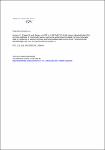EHEC/EAEC O104:H4 strain linked with the 2011 German outbreak of haemolytic uremic syndrome enters into the viable but non-culturable state in response to various stresses and resuscitates upon stress relief
Aurass, Philipp
Prager, Rita
Flieger, Antje
Various non-spore forming bacteria, including Escherichia coli, enter a dormant-like state, the viable but non-culturable (VBNC) state, characterized by the presence of viable cells but the inability to grow on routine laboratory media. Upon resuscitation, these VBNC cells recover both culturability and pathogenicity. In 2011, a large outbreak involving more than 3000 cases of bloody diarrhoea and haemolytic uremic syndrome was caused by an E. coli O104:H4 strain expressing genes characteristic of both enterohaemorrhagic (EHEC) and enteroaggregative E. coli (EAEC). The ability of the outbreak strain to enter the VBNC state may have complicated its detection in the suspected sources. In this paper, we investigated the ability of the outbreak strain to enter and subsequently recover from the VBNC state. We found that in a nutrient-poor micro-environment, various stresses such as toxic concentrations of copper ions or certain types of tap water are able to render the bacteria unculturable within a few days. Without copper ion stress, the majority of cells remained culturable for at least 40 days. Incubation with the stressors at 23°C compared with 4°C hastened this observed loss of culturability. The integrity of a considerable fraction of copper ion- and tap water 1-stressed bacteria was demonstrated by live/dead staining and microscopy. Relieving stress by copper-ion chelation facilitated resuscitation of these bacteria while preserving their fitness, major virulence gene markers (stx2, aggR, aggA genes) and specific phenotypes (ESBL resistance, autoaggregation typical for EAEC strains).
No license information
Related Items
Show related Items with similar Title, Author, Creator or Subject.
-
2014-03-13ZeitschriftenartikelMortality and molecular epidemiology associated with extended-spectrum β-lactamase production in Escherichia coli from bloodstream infection Leistner, Rasmus; Sakellariou, Christian; Gürntke, Stephan; Kola, Axel; Steinmetz, Ivo; Kohler, Christian; Pfeifer, Yvonne; Eller, Christoph; Gastmeier, Petra; Schwab, FrankBackground: The rate of infections due to extended-spectrum β-lactamase (ESBL)-producing Escherichia coli is growing worldwide. These infections are suspected to be related to increased mortality. We aimed to estimate the ...
-
2017-11-13ZeitschriftenartikelRisk of Transmission of Antimicrobial Resistant Escherichia coli from Commercial Broiler and Free-Range Retail Chicken in India Hussain, Arif; Shaik, Sabiha; Ranjan, Amit; Nandanwar, Nishant; Tiwari, Sumeet K.; Majid, Mohammad; Baddam, Ramani; Qureshi, Insaf A.; Semmler, Torsten; Wieler, Lothar H.; Islam, Mohammad A.; Chakravortty, Dipshikha; Ahmed, NiyazMultidrug-resistant Escherichia coli infections are a growing public health concern. This study analyzed the possibility of contamination of commercial poultry meat (broiler and free-range) with pathogenic and or multi-resistant ...
-
2014-04-10ZeitschriftenartikelResults of surveillance for infections with Shiga toxinproducing Escherichia coli (STEC) of serotype O104:H4 after the large outbreak in Germany, July to December 2011 Frank, Christina; Milde-Busch, Astrid; Werber, DirkAfter the massive outbreak of infections with Shiga toxin-producing Escherichia coli (STEC) of serotype O104:H4 in Germany in the summer of 2011, post-outbreak surveillance for further infections with this type of STEC was ...

